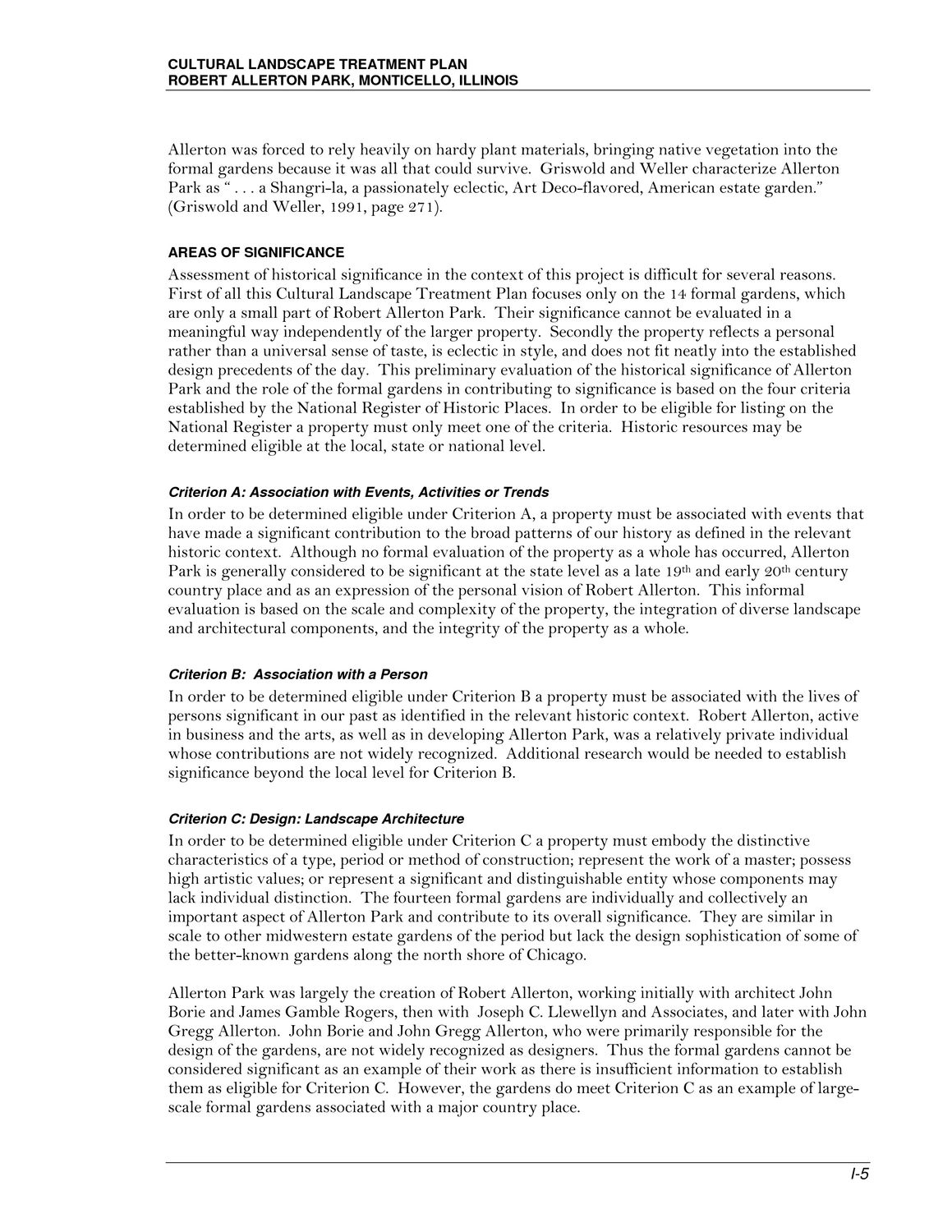Caption: Map of UIUC (2001) (Allerton)
This is a reduced-resolution page image for fast online browsing.

EXTRACTED TEXT FROM PAGE:
CULTURAL LANDSCAPE TREATMENT PLAN ROBERT ALLERTON PARK, MONTICELLO, ILLINOIS Allerton was forced to rely heavily on hardy plant materials, bringing native vegetation into the formal gardens because it was all that could survive. Griswold and Weller characterize Allerton Park as “ . . . a Shangri-la, a passionately eclectic, Art Deco-flavored, American estate garden.” (Griswold and Weller, 1991, page 271). AREAS OF SIGNIFICANCE Assessment of historical significance in the context of this project is difficult for several reasons. First of all this Cultural Landscape Treatment Plan focuses only on the 14 formal gardens, which are only a small part of Robert Allerton Park. Their significance cannot be evaluated in a meaningful way independently of the larger property. Secondly the property reflects a personal rather than a universal sense of taste, is eclectic in style, and does not fit neatly into the established design precedents of the day. This preliminary evaluation of the historical significance of Allerton Park and the role of the formal gardens in contributing to significance is based on the four criteria established by the National Register of Historic Places. In order to be eligible for listing on the National Register a property must only meet one of the criteria. Historic resources may be determined eligible at the local, state or national level. Criterion A: Association with Events, Activities or Trends In order to be determined eligible under Criterion A, a property must be associated with events that have made a significant contribution to the broad patterns of our history as defined in the relevant historic context. Although no formal evaluation of the property as a whole has occurred, Allerton Park is generally considered to be significant at the state level as a late 19th and early 20th century country place and as an expression of the personal vision of Robert Allerton. This informal evaluation is based on the scale and complexity of the property, the integration of diverse landscape and architectural components, and the integrity of the property as a whole. Criterion B: Association with a Person In order to be determined eligible under Criterion B a property must be associated with the lives of persons significant in our past as identified in the relevant historic context. Robert Allerton, active in business and the arts, as well as in developing Allerton Park, was a relatively private individual whose contributions are not widely recognized. Additional research would be needed to establish significance beyond the local level for Criterion B. Criterion C: Design: Landscape Architecture In order to be determined eligible under Criterion C a property must embody the distinctive characteristics of a type, period or method of construction; represent the work of a master; possess high artistic values; or represent a significant and distinguishable entity whose components may lack individual distinction. The fourteen formal gardens are individually and collectively an important aspect of Allerton Park and contribute to its overall significance. They are similar in scale to other midwestern estate gardens of the period but lack the design sophistication of some of the better-known gardens along the north shore of Chicago. Allerton Park was largely the creation of Robert Allerton, working initially with architect John Borie and James Gamble Rogers, then with Joseph C. Llewellyn and Associates, and later with John Gregg Allerton. John Borie and John Gregg Allerton, who were primarily responsible for the design of the gardens, are not widely recognized as designers. Thus the formal gardens cannot be considered significant as an example of their work as there is insufficient information to establish them as eligible for Criterion C. However, the gardens do meet Criterion C as an example of largescale formal gardens associated with a major country place. I-5
|